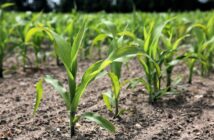Maize growers need to watch out for a rapid flush of weeds in newly sown crops following the recent turn in weather conditions across much of the country, advises Neil Groom technical director for maize specialists Grainseed Ltd.
The dry seedbeds common on many farms have kept the fields largely clean to date, but this will quickly alter after the recent rains, he warns.
“Mid May rain and rising temperatures will see maize crops and competitive weeds emerge rapidly now and this could be a problem if left unchecked.
“It’s important to get your agronomist to walk your crops so a sound post-emergence herbicide strategy can be adopted and actives applied at the optimum time.”
Work by the Maize Growers Association has shown the first 6 weeks after emergence is one of the most important stages of the crops development and keeping it weed free has a significant impact on final yields, he points out.
“Weeds need to be sprayed at cotyledon or first true leaf stage. When it’s warm, they can grow rapidly and by the time they reach the top of your boots, it’s too late. They need to be killed when they are small.”
With low yields of first cut silage and a lack of rain during the spring, many growers are also re-evaluating their winter forage stocks and putting in extra maize fields, Neil Groom comments.
“If you’re drilling in the second half of May, then choose a variety that is 2 maturity classes earlier than you would normally – so use a maturity class 8 if you normally drill maturity class 6 varieties and a 10 if you drill an 8.
“That will help ensure they finish at the right time and produce high levels of starch and energy.”
Once we are into June, drill the earliest variety possible, he advises.
“A variety such as Picker or Ardent will ensure you achieve 30% dry matter and 30% starch at harvest in October.
“Whether you are feeding dairy or beef or the maize is a feedstock for an AD plant, it has to be mature.”




